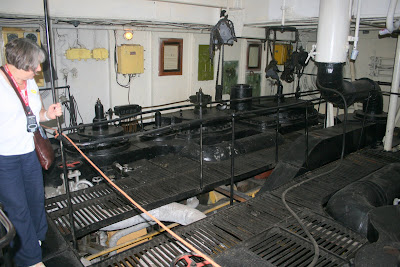On 5th August we flew to Tallinn. It was for the wedding of Michael and Kate Winter at the Alexander Nevsky Cathedral. We spent a fabulous few days enjoying Tallin and the fantastic wedding and celebrations. As part of the visit we couldn't resist having at least one nautical event, so we visited the
Estonia Maritime Museum in Tallin.
The whole museum is fascinating. The vessels on display are indicative of the turmoil that existed in the last century in the Baltic. All have mixed histories but for us the two "stars" were the
submarine Lembit (yes the same forename as the Liberal Democrat MP) and the
ice breaker Suur Toll. However, the civil engineering masterpiece of the
stressed concrete seaplane hanger shouldn't be ignored.
The submarine Lembit (1936)
What is also remarkable is the freedom that visitors to the museum have to explore the vessels. For example, the complex engine room of the Suur Toll is fully accessible. I personally found it thrilling to be able to clamber up and down the companion ways of its large three steam engines.
So what of the exhibits? The submarine Lembit was built in Barrow in Furness by Vickers Armstrong in 1938 for the then independent Estonian Republic. Lembit was one of two submarines built in the UK for Estonian. She survived but her sister ship, the Kalev, was sunk during WWII. She displaces 853 tonnes when submerged and is 59.5 m long. Her main role was mine laying but she has 4 torpedo tubes. She was operated by the Soviet Navy during WWII laying mines to protect what was then Leningrad (now St Petersburg). She was exhibited at a museum from 1985 and then handed over to the new Estonian government when it was formed in 1992. It was chilling to read that in 1940 when she became a Soviet vessel her Estonian crew were replaced and her commander was arrested and executed on orders from the NKVD (to become the KGB).
Her cramped living accommodation is a reminder of how difficult conditions were on submarines of that era - she had a complement of 32.
Torpedo tubes on the submarine Lembit
Mine storage on the Lembit (20 off)
Bunks (note they are two deep)
Up Periscope!
One of the two original diesel engines (Lembit is diesel-electric)
How to steer a submarine!
The icebreaker Suur Toll was built in 1914 by Vulcan-Werke, Hamburg in what was then Stettin, Germany but is now is Szczecin, Poland. She has played an important part in the maritime history of the Baltic. She was at one time the biggest icebreaker in the world and for her to survive two world wars is remarkable in itself.
Suur Toll icebreaker (1914)
She was operated by the Russian Bolsheviks during WWI but was captured by Finland in 1918 and then handed over to the newly independent Estonia in 1922. She was then handed over to the Soviet fleet in 1941 and served as an icebreaker until she was made a museum ship in 1988.
Bows of the Suur Toll (note the sunbather on the boat below)
One of three steam engines on Suur Toll
Two of the three furnaces on Suur Toll
There are numerous stories of how she managed to keep the Baltic ports supplied during war and how important she has been to Tallin, her home port. But despite all her history it is her technical innovation that still stands out. She displaces 4,579tonnes and is 74.4 m in length but she is packed with power. She has three 5800 HP independently operated steam engines driving two forward screws and one reverse which is placed under the bow. She was originally coal fired but is now diesel fired. When you go below decks it is very unnerving to find a sizable propeller shaft going forward. My first impression was that I had taken the wrong turn and that I was going towards the stern and not forwards. There is very little below decks except engines, boilers and furnaces! The top deck has some reasonable accommodation for officers and crew but little else. Some pictures of the Suur Toll on display in the museum show her in a dry dock with bolt-on propeller (screw) blades (four per propellor). Presumably this was to help replacement if damaged.

Above the two foward driving engines of Suur Toll
So what of the seaplane hanger. It is a pre-stressed concrete shell structure built on the orders of the last Tsar of Russia. Its designer was Danish, as was the constructor. Between the wars the seaplane base site was an important strategic site for the fledgling republic of Estonia and was famously visited by Charles Lindberg of the Spirit of St Louis fame.
Former seaplane hanger at Tallin, Estonia
As you can imagine I had a great day and I can safely say that Maggie was also impressed.
Enjoy some of our photographs.
Steve Parkin



